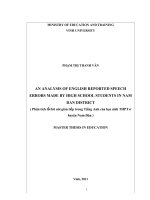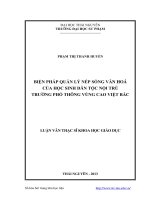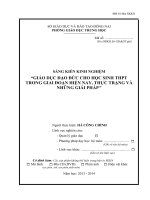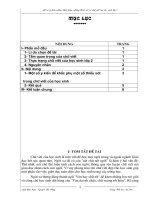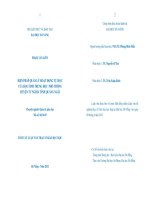Những lỗi thuộc về văn hóa của học sinh THPT ở kim xuyên tuyên quang thực tế và ý kiến
Bạn đang xem bản rút gọn của tài liệu. Xem và tải ngay bản đầy đủ của tài liệu tại đây (683.06 KB, 92 trang )
THAI NGUYEN UNIVERSITY
SCHOOL OF FOREIGN LANGUAGES
TRIEU THI THUY LOAN
Cultural mistakes made by students from a
high school in Kim Xuyen - Tuyen Quang:
Realities and opinions
(Những lỗi thuộc về văn hóa của học sinh THPT
ở Kim Xuyên - Tuyên Quang: thực tế và ý kiến)
M.A THESIS
Field: English Linguistics
Code: 8220201
Thai Nguyen, 2019
THAI NGUYEN UNIVERSITY
SCHOOL OF FOREIGN LANGUAGES
TRIEU THI THUY LOAN
Cultural mistakes made by students from a
high school in Kim Xuyen - Tuyen Quang:
Realities and opinions
(Những lỗi thuộc về văn hóa của học sinh THPT
ở Kim Xuyên - Tuyên Quang: thực tế và ý kiến)
M.A THESIS
(APPLICATION ORIENTATION)
Field: English Linguistics
Code: 8220201
Instructor: Dr. Nguyen Trong Du
Thai Nguyen, 2019
DECLARATION
I, the undersigned, hereby certify my authority of the study project report entitled
“Cultural mistakes made by students from a high school in Kim Xuyen – Tuyen
Quang: realities and opinions” is the result of my own research for the Degree of
Master in English Language. Except where the reference is indicated, no other
person’s work has been used without due acknowledgement in the text of the thesis.
Appro
ved by
T
h
a
i
SUPE
RVIS
OR
Dr.
Ng
uy
en
Tr
on
g
Du
N
g
u
y
e
n
,
2
0
1
9
R
e
s
e
a
r
c
h
e
r
’
s
s
i
g
n
a
t
u
r
e
T
r
i
e
u
T
h
i
T
h
u
y
L
o
a
n
ACKNOWLEDGEMENTS
First and foremost, I would like to express my sincere gratitude to Dr.
Nguyen Trong Du, my supervisor, who has patiently and constantly supported me
through the stages of the study, and whose stimulating ideas, expertise, and
suggestions have inspired me greatly through my growth as an academic researcher.
I would like to take this opportunity to express my gratitude to the lecturers
of the Department of Post-graduate Studies, School of Foreign Languages, Thai
Nguyen University for my useful lessons during two years studying here. I am also
thankful to selected teachers, students from at Kim Xuyen High School for their
whole-hearted participation in the study.
I also wish to give my heartfelt thanks to my family members, my closed
friends who I have never enough words to express my great gratitude for their
encouragement and inspiration.
Eventually, the study has been completed to the best of my knowledge;
however, mistakes and shortcomings are unavoidable. Therefore, I look forward
to receiving comments and suggestions from readers for the perfection of the
course work.
ABSTRACT
In recently years, it is important for English teachers to integrate culture
so as to raise the awareness of their students about the differences between
cultures when they want to use English to communicate with foreigners. In this
study, the researcher aimed to find out some of the so-called cultural mistakes made
by students in a high school in Kim Xuyen. It mainly explores the mistakes related
to greetings, addressing the interlocutors, or responding to those acts. In order to
achieve the objectives, the researcher uses both quantitative and qualitative research
methods to collect the data: Questionnaires and Interviews. The participants were
five teachers and 150 students in different classes at Kim Xuyen High School. The
results show that most students and even teachers speak English in a very
Vietnamese way, which is claimed by an American teacher to be a type of cultural
mistakes. However, the results also reveal that those mistakes may not be avoidable
because English is spoken within the context of Vietnamese culture. This study is a
modest contribution for teachers who wish to improve their attitudes towards the
mistakes of students.
TABLE OF CONTENT
DECLARATION ........................................................................................................ i
ACKNOWLEDGEMENTS ....................................................................................... ii
ABSTRACT .............................................................................................................. iii
TABLE OF CONTENT ............................................................................................ iii
LIST OF ABBREVIATIONS ................................................................................... vi
LIST OF TABLES AND CHARTS......................................................................... vii
CHAPTER 1: INTRODUCTION............................................................................1
1. Rationale: ................................................................................................................1
2. Aims of the study ....................................................................................................2
3. Research questions ..................................................................................................3
4. Scope of the study ...................................................................................................3
5. The significance of the study ..................................................................................3
6.
Methods
of
the
...............................................................................................4
study
7. Design of the study.................................................................................................4
CHAPTER 2: LITERATURE REVIEW................................................................6
2.1. Definitions of Culture ..........................................................................................6
2.2.
The
relationship
...................................................6
between
language
and
culture
2.3. Typical features of learning English in Vietnam .................................................7
2.4. Language, culture and communication ................................................................8
2.5. Pragmatics and pragmatic competence ................................................................9
2.5.1. Pragmatics .........................................................................................................9
2.5.2. Pragmatic competence ......................................................................................9
2.6. Intercultural Communication Competence ........................................................10
2.7. Cultural mistakes .............................................................................................11
2.8. Misunderstanding of culture mistakes. ..........................................................12
CHAPTER 3: METHODOLGY .........................................................................13
3.1. Quantitative method applied in the study ..........................................................13
3.2. Qualitative method applied in the study ............................................................14
3.3. Research procedure...........................................................................................14
3.4. Setting of the study ...........................................................................................15
3.5. Subjects of the study.........................................................................................16
3.6. Data collection instruments................................................................................16
3.7. Questionnaire .....................................................................................................16
3.8. Observations.......................................................................................................17
3.9. Structured interview ...........................................................................................18
3.10. Data analysis procedure ...................................................................................19
3.11. Data analytical methods ...................................................................................19
CHAPTER 4: FINDINGS AND DISCUSSION ..................................................21
4.1. Data analysis ......................................................................................................21
4.1.1. Cultural mistakes: realities ..............................................................................21
4.1.2. Cultural mistakes: students’ opinions
.................................................................28
4.2. The results from interviews................................................................................33
4.2.1. Students’ opinions ...........................................................................................33
4.2.2. Teachers’ opinions ..........................................................................................37
4.3. Findings and discussion .....................................................................................39
CHAPTER 5: CONCLUSION...............................................................................41
5.1. Summary ............................................................................................................41
5.2. Implications. ......................................................................................................42
5.2.1. For the English teachers ..................................................................................42
5.2.2. For other researchers .......................................................................................42
5.2.3. For course-book designers ..............................................................................43
5.2.4. Limitations of the research..............................................................................43
REFERENCES ........................................................................................................44
APPENDICES .........................................................................................................47
LIST OF ABBREVIATIONS
FIG:
Focus interviews group
EL:
English language
Ss:
Students
LIST OF TABLES AND CHARTS
TABLES
Table 1: students’ answer to question 1 ....................................................................21
Table 2: students’ answer to question 2 ....................................................................22
Table 3: students’ answer to question 3 ....................................................................23
Table 4: students’ answer to question 4 ....................................................................23
Table 5: students’ answer to question 5 ....................................................................24
Table 6: students ’answer to question 6 ....................................................................25
Table 7: students’ answer to question 7 ....................................................................25
Table 8: students’ answer to question 8 ....................................................................26
Table 9: students’ answer to question 9 ....................................................................26
Table 10: students’ answer to question 10 ................................................................27
CHARTS
Chart 1. Students’ opinions........................................................................................29
Chart 2. Students’ opinions........................................................................................30
Chart 3. Students’ opinions........................................................................................31
Chart 4. Students’ opinions........................................................................................32
CHAPTER 1: INTRODUCTION
1. Rationale:
Vietnam has been on the way of strong development and increased
integration in all respects including the comprehensive and profound reform in
education, especially in language teaching and learning. The active participation of
Vietnam in regional and international associations and the recent adoption of market
economy have stimulated the importance of English as an international language in
the country (Le & Barnard, 2009). English language has attracted significant
consideration from wide range of
Vietnamese communities. Vietnamese
government has stimulated a huge project of language teaching and learning called
the National Foreign Language Projects with impressive determination to improve
the English education in the nation wide scale till 2025.
However, the practice of teaching and learning English in mountainous areas
is facing with lots of difficulties. I am teaching English at a high school in Kim
Xuyen
- Tuyen Quang where seventy - five percent of the students are ethnic minorities and
have low living standard, and I recognize that they often make a number of
mistakes, especially ones related to the appropriate use of language items real-life
conversations. From my observation, most of those mistakes are caused by the
impact of Vietnamese culture.
Learning a language is learning a new culture. In order to communicate
successfully, learning the language aspects such as grammar, vocabulary, listening,
or speaking is not enough; it is important to learn the cultural factors of that
language. Sometimes, learners speak English with correct pronunciation but they
are still misunderstood or the conversation between them and native speakers is not
smooth because they use inappropriate language in specific contexts.
The research is based on some situations within the particular area of
language education for communicating across culture. Language and culture are
inseparable and culture is influential on all levels of communication, from forming
the context for communication to the culture content embedded in linguistic units
(Crozet & Liddicoat, 1999, 2000). Dan Hauer has made a series of videos showing
the fact that
Vietnamese learner of English often make some common mistakes: Vietnamese
names are written as Last Name + Middle Name + First Name (Nguyen Van A;
Pham Thi B, which is opposite to the way people use different to American. The
first Vietnamese name is normally used appropriate to be Mr. Nam, Mrs. Hoa and
the Vietnamese do not use the last name to address someone. Besides, Kim Xuyen
students call or greet their teachers as "Good morning, Teachers" as a way of
addressing Vietnamese. The video of Dan Hauer often says “it is incorrect or in his
America country”, in his country, they do not use greetings such as: How are you?
I'm fine, thank you, and you? ; Whether or not to use "Good morning, teacher" etc.
Dan Hauer listed the mistakes in his video so the researcher based on these
communication mistakes, observed, questionaire and interviewing students of Kim
Xuyen High School. From the imfacts of Vietnamese culture, the researcher would
help students in Kim Xuyen High school distinguish their cultural mistakes. This
study helps English teachers to understand certain difficulties that Vietnamese
students might encounter due to cultural differences. Otherwise, this study will help
Kim Xuyen students who study English or to become aware of their own sociocultural behaviors towards communication in order to reduce cultural mistakes
misunderstandings. The last the implications of this study would be relevant to
language teaching in other cultural. The researcher has relied on Dan Hauer's videos
to investigate whether those mistakes were made by Kim Xuyen students or those
mistakes were incorrectly not used by native speakers. At the same time, the
researcher has also pointed out that what he said that was not right, not consistent
with the usage style of Vietnamese people, the words must be full such as: "Hello
teacher = Good morning, Teacher" don't just use "Good morning". Understanding
mistakes here are not grammatically and phonetically, but they might be
misunderstandings or influenced by Vietnamese culture. Finally, watching those
clips gave me the idea of conducting this study.
2. Aims of the study
Professor Hu Wenzhong (1999) thinks that the cultural mistakes is more
serious than the language errors, because it is easy to cause emotional unpleasant
between foreigners and Chinese. Therefore, how should we use language correctly
and appropriately is an important part of the intercultural communicative
competence.
The first aim of study is to investigate what are common cultural mistakes
that high school students make in initial stages of communication such as greetings
and responding to greetings, inviting and accepting/refusing etc. The researcher
also expects to explore teachers and students’ opinions about whether those mistakes
must be avoided in every context.
3. Research questions
From those aims, two research questions are set out:
1. What are common mistakes high school students make in initial turns of
conversations?
2. What are the teachers’ and students’ opinions about whether those mistakes
must be avoided in every context?
4. Scope of the study
This study focuses on investigating the mistakes occurring in the initial turns
of conversations. As such, it mainly explores the mistakes related to greetings,
addressing the interlocutors, or responding to those acts. Generally, initial turns can
vividly reveal the impact of Vietnamese culture on the students’ performance of
English. In this study, the researcher only concentrates on a group of students in a
remote and mountainous area where there is a lack of a good English speaking
environment. Thus, the findings might not be representative for all Vietnamese high
school students.
5. The significance of the study
Firstly, the study is conducted to find out some cultural mistakes which
students have made when they communicate with foreigners. Hopefully, the
findings of the study contribute theoretically and practically to the improvement of
speaking process. On the other hand, the research can bring a number of benefits to
involve namely students, teachers, educational administrators and researchers of the
related fields. Secondly, teachers Kim Xuyen High School as well as English
teachers in Tuyen Quang province are those who receive benefits from the
information the
research provides. The findings can be used as suggestions for teachers. Teachers
will have an overall look at the situations in video of Dan Hauer to have the right
ways for students to communicate. Thirdly, the study is also necessary for the
students. It is expected that the students can more active when they speak English
and confident to communicate English well. Finally, the study can give contribution
to other researchers as references in conducting further research. They may get
other techniques to encourage students to talk. In general, students, teachers,
educational administrators and researchers are those who are likely to benefit from
the study.
6. Methods of the study
Based on the aim of the study, the researcher used two methods of study:
quantitative and qualitative. The quantitative data were collected with the use of
questionnaires for students to identify the cultural mistakes made during the first
turns of everyday conversations. This type of data was analyzed via Microsoft
Excel. The analysis of this type of data aimed to answer the first research
question. The qualitative data were collected via interviews of teachers and students
which aimed at dealing with the second research question. Besides, all comments,
recommendations and conclusions will be made based on the data analysis. The data
collected will contribute to the confirmation and support of the results which have
been gained from the previous studies
7. Design of the study
This research is divided into five chapters.
CHAPTER 1, INTRODUCTION, presents the rationale, the aims, research
questions, significance, method and design of the study.
CHAPTER 2, LITERATURE REVIEW, presents some concepts most
relevant to the research topic such as definition of culture, the relationship between
language and culture, typical features in learning in Vietnam in the classroom,
language, culture and communication, pragmatic competence, and intercultural
communication competence.
CHAPTER 3, METHODOLOGY, provides the methodology underlying the
research which includes the general information about study subjects. This chapter
also focuses on the methods of data collection.
CHAPTER 4, FINDINGS AND DISCUSSION, gives a detailed presentation
of data and a detailed description of data analysis. Some explanations and
interpretations of the findings of the study are also presented.
CHAPTER 5, CONCLUSION, emphasizes the implication of the study in
which certain furthermore, this chapter also points out the limitations of the study
and provides some suggestions for further studies.
CHAPTER 2: LITERATURE REVIEW
This
chapter
presents
background
knowledge
of
culture,
the
relationship between language and culture, typical features in learning in Vietnam
in the classroom, language, culture and communication, pragmatic competence,
intercultural communication competence, cultural mistakes and misunderstanding
of culture mistakes concerning the topic of the study.
2.1. Definitions of Culture
UNESCO (1996:108) launches the formal definition focusing on the character
of culture as follows,
“Culture is a set of symbolic systems which regulate the behaviour and
enable the mutual communication of a plurality of people, establishing
them into particular and instinct community. In its widest sense, culture
may now be said to be the whole complex of distinctive spiritual,
material, intellectual and emotional features that characterize a society or
social group. It includes not only the arts and letters, but also modes of life,
the fundamental rights of the human being, value systems, traditions and
beliefs (UNESCO, 2001:148)”. Cultures around the world share six common
characteristic: it is shared, it is
learned, it is based on symbols, it is dynamic, it is integrated, and it is ethnocentric
(Haviland, 2002).
“A culture is a configuration of learned behaviors and results of behavior
whose component elements are shared and transmitted by the members of a
particular society”. (Linton, R.1945:p.32)
According to Block (2001), “Culture, in its broadest sense, is what makes you
a stranger when you are away from home. It includes all beliefs and expectations
about how people should speak and act which have become a kind of second
nature to you as a result of social learning. When you are with members of a
group who share your culture, we or you do not have to think about it, for you are
all viewing the world in pretty much the same way and you all know, in
general terms, what to expect of one another”.
2.2. The relationship between language and culture
Culture profoundly influences the development of language. “It is culture,
responding to its particular ecological role that provides the bulk of the conceptual
packages that are coded in any particular language” (Levinson, 2003: p.26-27). In
fact, Levinson continues, “the contents of language, and much of its form, are thus
largely the products of cultural tradition” (Ibid: p.27).
So, various, culturally-
influenced systems may thus clash due to the differences in the expectations of
and the methods employed by both teachers and students involved in a crosscultural, second language learning process. “As teacher, student interaction is such
an archetypal human phenomenon, and so deeply rooted in the culture of a
society; cross-cultural learning situations are fundamentally problematic for both
parties” (Hofstede: 1986: p.303).
The language teachers have been addressing the need to include cultural
knowledge into second and foreign language teaching. Brown (2000) is convinced
there is a connection between language and culture. He says, “It is apparent that
culture… becomes highly important in the learning of a second language”.
The crucial focus of second and foreign language teaching has been directed
towards dispensing the rules of grammar and increasing the knowledge of
vocabulary in the target language so that one can produce correct utterances
in order to communicate. In other words, competency in linguistic knowledge
does not guarantee successful use of the language. "Cultural competency" (e.g.,
Alptekin,
1993; Beamer, 1992) is necessary in order to carry on fruitful communication.
2.3. Typical features of learning English in Vietnam
According to Tuong Hung Nguyen (2002) some common problems facing
Vietnamese learning English are: non-use of be in sentences consisting of subject
and adjective (e.g. She beautiful); and word-by-word translation, among others.
Vietnamese students tend to copy down, and hence rely on, everything written on
the board. Free lecturing would handicap many students who have not familiarized
themselves with listening and note-taking skills. On the whole, their written English
is better than their spoken English. Some Vietnamese students may not look in the
eyes of the teacher; this is not because of disrespect, but out of fear or reverence,
so
to speak. It would be safe to avoid touching the students, and allow them to call
the teacher ‘Teacher’. Since keeping quiet in class is to show respect to teachers as
well as to create a productive learning environment, being talkative, interrupting,
bragging, or challenging the teacher are not typical of Vietnamese culture. Such
behavior is strongly criticized and avoided. It is not ofensive in Vietnamese culture
to ask personal questions regarding age, marital status, salary, religion, etc. Don’t
be shocked, but be prepared to explain to them a list of personal questions that
make foreign teachers uncomfortable. In this culture, a comment on weight gain is
a compliment; on the contrary, a remark on weight loss is not complimentary.
Vietnamese names are written as Last Name + Middle Name + First Name
(e.g., Nguyen Thi An), which is opposite to the way people (including overseas
Vietnamese) write their names in America. To address someone, the first name is
normally used between equals in an informal context. The appropriate form of
address in formal situations is a Title + First name, as in Mr. Nam – the Vietnamese
do not use last name to address someone.
All students in Vietnam always say: “chào Thầy, chào Cô” meaning “Hello,
teacher”. But native speakers do not greet their teacher like that. According to Dan
Hauer who has made a series of videos on Vietnamese students’ performance of
English, Vietnamese learners of English often make some common mistakes related
to the impact of culture. For examples, he said that in America, students always call
their teachers by their last name, along with Mrs., Miss. or Mr. All of college and
university students usually call their professors by their first names. And if they
meet an unfamiliar teacher, whose name they do not know, they often say “Hello”
not “Hello, teacher”.
Other types of mistakes can be found in the following utterances. For
example,
from a native speaker’s perspective “Can you eat……?”(meaning “Bạn có ăn được
……không?) is not used to ask about likes of dislikes; it is a question about
someone’s ability. When asking about likes or dislikes, “Do you like eating……?”
should be used instead.
2.4. Language, culture and communication
Both of language and culture have a function of communication because
they both carry meanings. On the one hand, language carries syntactic, semantic
and pragmatic meanings for language users to communicate (Brooks, 1997). On the
other hand, culture carries meanings and cultural meanings are expressed through
patterns of behaviour, e.g., language. In order to communicate successfully across
languages and cultures, one must understand culturally diferent norms of
interaction and people’s values and thought (Saville-Troike, 2003). Sometimes
linguistic correct sentences could cause misunderstanding or confusion when they
are in a diferent cultural context (Schulz, 2007).
2.5. Pragmatics and pragmatic competence
2.5.1. Pragmatics
According to the Longman Dictionary of Language Teaching & Applied
Linguistics (p. 384), pragmatics is a study of the use of language in communication,
especially the relationships between sentences and expressions, scenes and
situations in which they are used. Applied learning is sometimes opposed to the
term learning, which refers to the meaning without mentioning the user and the
communication functions of the sentence. Pragmatics is sometimes contrasted
with semantics, which deals with meaning without reference to users and
communicative functions of sentences.
Pragmatics is often described as the study of language use (Sperber and
Wilson, 2005: p.468). In this instance, Pragmatics deals with the study of the
relation of signs to interpreters. Whereas the other two branches of Semiotics
include Syntactics or Syntax, the study of formal relations of signs to one another,
and Semantics, the study of the relation of signs to the objects to which the signs
are applicable (Levinson, 1995: p.1). Within this threefold branch, only Pragmatics
can be investigated. It is due to the fact that only Pragmatics may discover
people’s intended meanings, their assumptions, their purposes or goals, and the
sorts of actions when they are performing when they speak (Yule, 1996: p.3)
Số hóa bởi Trung tâm Học liệu và Công nghệ thông tin – ĐHTN

